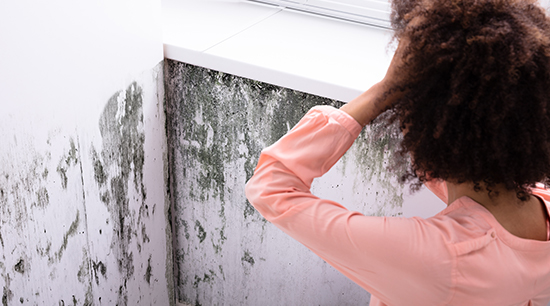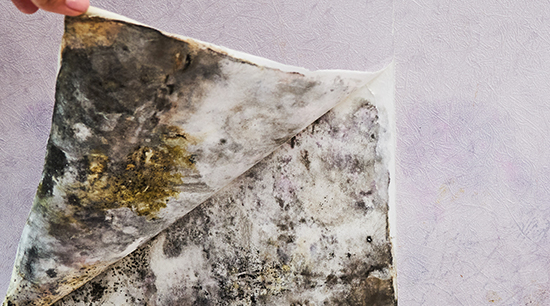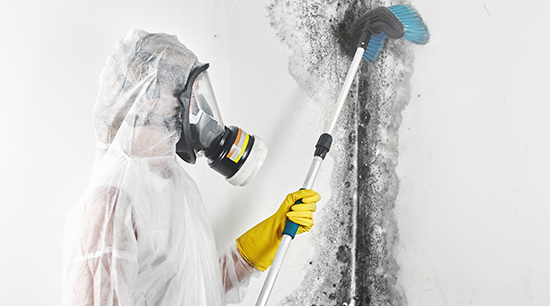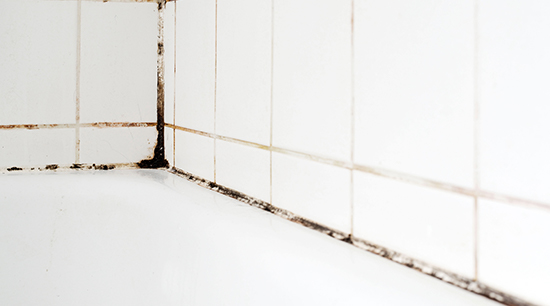Black Mold vs. Mildew
Prevent severe illness from debilitating you and your loved ones. Knowing how to differentiate between black mold and mildew will help you avoid allergic reactions, respiratory infections, and potential long-term illnesses.

alpharettawaterdamageremoval.com gathered the following information about the differences between black mold and mildew in your home and what to do when you find it.
What is Black Mold?

Stachybotrys chartarum, known as black mold or toxic black mold, is a microfungus that produces its spores in what are referred to as slime heads. Black mold is often detected in soil and grain, but the mold is most often found in cellulose-rich building materials (fiberboard, gypsum board, and paper) from poorly ventilated, damp, or water-damaged buildings. In unaired or ‘stale’ places, like basements, mold can produce a strong, musty, and highly recognizable odor.
Appearance – Black mold is often darker in color. When trying to identify black mold, look for circular black, dark green, or dark brown spots. Some types of black mold may also appear in shades of orange or have specs of white in them. Usually, black mold will appear to be slightly fuzzy.
Health Risk – Stachybotrys chartarum, among other mold varieties, can cause nonspecific health symptoms. It is not always necessary to determine the type of mold you may have growing in your home or building. However, all molds should be treated the same in regard to potential health risks and its removal.
Mold Cleanup – Always consider the size of the mold problem. If the moldy area is less than a 3 ft. by 3 ft. area, you should be able to handle the job yourself. For larger or more complicated areas, hire a trained contractor to perform the mold removal process. The following steps will help you safely remove small areas of mold:

- Wear personal protective equipment (mask, long-sleeve shirt, protective eyewear, etc.)
- Fix any plumbing leaks or cease any water/humidity source that may be fueling mold growth
- Make sure the affected area is completely dry
- Use detergent and water to scrub mold off of hard surfaces
- Porous material like drywall and carpet may have to be removed
- After removal, maintain the area dry and well-ventilated
- Only apply paint or caulk after the affected area is mold-free and completely dry
- If you have any concerns about mold removal, hire a trained contractor to perform this service
Further reading on mold cleanup, removal, and advisories can be found at epa.gov/mold/mold-cleanup-your-home
Note: While bleach is highly effective in eliminating surface mold, the water used to dilute it can soak into porous material and fuel mold regrowth.
Tip: If you have problems with asthma, COPD, or if you are immune-compromised in any way, you should not expose yourself to a moldy home or even be present while it is being removed and cleaned.
What is Mildew?

Mildew is a form of fungus that grows as multicellular filaments (hyphae). Molds can be found on practically any organic matter, including food, clothing, leather, paper, and quite commonly on the ceilings, walls, and floors of spaces with a moisture management problem. In unaired or ‘stale’ places, like basements, mildew can produce a strong, musty odor.
Appearance – Mildew is primarily distinguished from mold by its color. While molds appear in shades of black, blue, red, and green, mildew is found in shades of white, yellow, and sometimes light orange.
Health Risk – Mildew produces allergens and irritants, and inhaling or touching mildew may lead to allergic reactions in highly sensitive individuals. Allergic reactions may include hay fever symptoms like sneezing, runny nose, and red eyes.
Allergic reactions to mold and mildew are common, and they can be either immediate or delayed. Mildew can also prompt asthma attacks in those with asthma who are allergic to mildew. Mildew exposure can irritate the eyes, skin, nose, throat, and lungs of allergic and non-allergic people. Symptoms other than allergic and irritant types are not typically reported from inhaling mildew.
Mildew Cleanup – Always consider the size of the mold problem. You should be able to handle this cleanup job yourself. Like mold cleanup, for larger, more complicated areas, consider hiring a professional contractor to remove the mildew from the space. The following steps will help you safely remove small areas of mildew:
- Wear personal protective equipment (mask, long-sleeve shirt, protective eyewear, etc.)
- Fix any water/humidity issues or sources that may be fueling mildew growth
- Make sure the affected area is completely dried out
- As with mold, use detergent and water to scrub mildew off of hard surfaces
- Porous material like drywall and carpet may have to be professionally treated or removed
- After mildew removal, maintain the area dry and well-ventilated
- Only apply paint or caulk after the affected area is mildew-free and completely dry
- If you have any concerns about mildew removal, hire a trained contractor to perform this service
Note: Under the right conditions and concentrations, all molds and mildew can adversely affect human health.
Mold and Mildew
In this article, you discovered how black mold differs from mold, how to identify it, and what actions to take to protect your and your loved one’s health.
Knowing how to differentiate black mold from mildew will help you take appropriate protective measures against allergic reactions, sudden illness, and long-term illnesses caused by black mold.
Ignoring the presence of black mold in your home can lead to respiratory infections, the development of asthma, and long-term debilitating illnesses in all of your home’s occupants.
Sources:
epa.gov/mold/mold-cleanup-your-home
cdc.gov/mold/stachy.htm
epa.gov/mold/what-difference-between-mold-and-mildew
fema.gov/pdf/rebuild/recover/fema_mold_brochure_english.pdf
(678) 505-0266
The post Black Mold vs. Mildew appeared first on http://www.alpharettawaterdamageremoval.com

Comments
Post a Comment